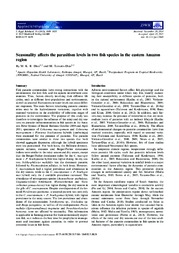Seasonality affects the parasitism levels in two fish species in the eastern Amazon region.
Seasonality affects the parasitism levels in two fish species in the eastern Amazon region.
Author(s): DIAS, M. K. R.; TAVARES-DIAS, M.
Summary: Fish parasite communities have strong interactions with the environment, the host fish, and the aquatic invertebrate communities. Thus, factors directly involving their different life cycles, such as different host populations and environments, as well as seasonal fluctuations in water levels can cause different responses. The main factors structuring parasite communities may be the hydrodynamic variations, together with seasonal variations in the availability of infectious stages of parasites in the environment. The purpose of this study was therefore to investigate the influence of the rainy and dry seasons on parasite infracommunities in fish species in the Amazon River System of Brazil. Between October 2009 and April 2011, specimens of Colossoma macropomum and Colossoma macropomum x Piaractus brachypomushybrids (tambatinga) were examined for the presence of parasites. The parasite communities were similar in these two species that both showed aggregate dispersion, although the hybrid specimens were less parasitized. For both hosts, the Brillouin diversity, species richness, evenness and Berger-Parker dominance indices were similar in the rainy season and dry season, except that the Berger-Parker dominance index for the C. macropomum x P. brachypomushybrid was higher during the dry season. Ichthyophthirius multifiliis was the dominant parasite, followed by Piscinoodinium pillulare, in both hosts. However, C. macropomumhad a higher prevalence and abundance in the dry season, while in the C. macropomum x P. brachypomushybrid, only the I. multifiliis prevalence increased. The abundance of monogenean species (Anacanthorus spathulatus, Linguadactyloides brinkmanni, Mymarotheciumand Notozothecium janauachensis) was higher during the dry season in the gills of C. macropomum. Despite over dispersion of the lernaeid Perulernaea gamitanae, a seasonal pattern was seen only in the C. macropomum x P. brachypomushybrid, with higher prevalence in the rainy season. The low prevalence and abundance of the ectoparasites Tetrahymenasp., Trichodinasp. and Braga patagonica, as well as of the endoparasites Procamallalus (Spirocamallanus) inopinatus and Neoechinorhynchus buttnerae, were not affected by seasonality. This information is applicable in farming practice for these economically important fish, as it indicates the best time for prophylactic management and treatment against parasites, in order to prevent economic losses in fish farms.
Publication year: 2015
Types of publication: Journal article
Unit: Embrapa Amapá
Observation
Some of Embrapa's publications are published as ePub files. To read them, use or download one of the following free software options to your computer or mobile device. Android: Google Play Books; IOS: iBooks; Windows and Linux: Calibre.
Access other publications
Access the Agricultural Research Database (BDPA) to consult Embrapa's full library collection and records.
Visit Embrapa Bookstore to purchase books and other publications sold by Embrapa.

